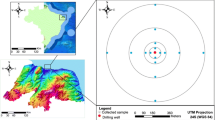Abstract
A mooring containing diverse carbonate and anhydrite substrates was exposed to bottom waters for 9 months at the base of the Florida Escarpment to determine the influence of dissolution on the development of this continental margin. Weight loss was measured on all samples. Etching, pitting, and loss of the original framework components were observed on substrates with known characteristics. Extrapolations of modern dissolution rates predict only about 1.6 meters of corrosion per million years. However, more rapid anhydrite dissolution, up to 1 km per million years, would cause exposed anhydrite beds to undercut and destabilize intercalated limestones.
Similar content being viewed by others
References
Applin, P.L. and Applin, E.R. 1965. The Comanche series and associated rocks in the subsurface in central and south Florida. U.S. Geological Survey Professional Paper 447. U.S. Government Printing Office, Washington, DC., 86 pp.
Berger, W.H. 1967. Foraminiferal ooze: solution at depth.Science 156:383–385.
Berger, W.H. 1976. Biogenous deep sea sediments: Production, preservation, and interpretation. In: Riley, J.P. and Chester, R. (Eds.), Treatise on Chemical Oceanography 5. Academic Press, London, pp. 265–388.
Commeau, R.F., Paull, C.K., Commeau, J.A., and Poppe, L.J. 1987. Chemistry and mineralogy of pyrite-enriched sediments at a passive margin sulfide brine seep: Abyssal Gulf of Mexico.Earth and Planetary Sciences Letters 82:62–74.
Dillon, W.P., Valentine, P.C., and Paull, C.K. 1987. The Blake Escarpment—A product of erosional processes in the deep ocean. In: Cooper, R. and Shepard, A.N. (Eds.), Scientific Application of Current Diving Technology on the U.S. Continental Shelf. U.S. Department of Commerce, Symposium Series for Undersea Research2:177–190.
Freeman-Lynde, R.P. 1983. Cretaceous and Tertiary samples dredged from the Florida Escarpment, Eastern Gulf of Mexico.Transactions Gulf Coast Associations Geological Societies 33:91–99.
Freeman-Lynde, R.P., Cita, M.B., Jadoul, F., Miller, E.F., and Ryan, W.B.F. 1981. Marine geology of the Bahamian Escarpment.Marine Geology 44:119–156.
Freeman-Lynde, R.P. and Ryan, W.B.F. 1985. Erosional modification of the Bahamian Escarpment.Geological Society of America Bulletin 96:481–494.
Fuetterer, D.K. 1974. Significance of the boring spongeCliona for the origin of fine grained material of carbonate sediments.Journal Sedimentary Petrology 44:79–84.
Honjo, S. and Eres, J. 1978. Dissolution rates of calcium carbonate in the deep ocean: Anin situ experiment in the North Atlantic.Earth and Planetary Science Letters 40:227–234.
Maher, J.C. 1971. Geologic framework and petroleum potential of the Atlantic Coastal Plain and continental shelf. U.S. Geological Survey Professional Paper 659. U.S. Government Printing Office, Washington, DC, 98 pp.
Metzler, C.V., Wenkam, C.R., and Berger, W.H. 1982. Dissolution of foraminifera in the eastern equatorial Pacific: Anin situ experiment.Journal Foraminiferal Research 12:362–368.
Milliman, J.P. 1977. Dissolution of calcium carbonate in the Sargasso Sea (Northwest Atlantic). In: Anderson, N.R. and Malahoff, A. (Eds.), The Fate of Fossil Fuel CO2 in the Oceans. Plenum Publishing, New York, pp. 641–653.
Neumann, A.C. 1966. Observations on coastal erosion in Bermuda and measurements of the boring rate of the sponge,Cliona lampa.Limnology and Oceanography 2:92–108.
Paull, C.K. and Dillon, W.P. 1980. Erosional origin of the Blake Escarpment: An alternative hypothesis.Geology 8:538–542.
Paull, C.K., Freeman-Lynde, R., Bralower, T., Neumann, A.C., Gardemal, M., D'Argenio, B., and Marsella, E. 1990. Geology of the Florida Escarpment: Observations and sampling from the research submersible ALVIN.Marine Geology 91:177–194.
Paull, C.K., Hecker, B., Commeau, R., Freeman-Lynde, R.P., Neumann, A.C., Corso, W.P., Golubic, S., Hook, J., Sikes, E., and Curray, J. 1984. Biological communities at Florida Escarpment resemble hydrothermal vent communities.Science 226:965–967.
Paull, C.K. and Neumann, A.C. 1987. Continental margin brine seeps: Their geological consequences.Geology 15:545–548.
Peterson, M.N.A. 1966. Calcite: Rates of dissolution in a vertical profile in the central Pacific.Science 154:1542–1544.
Thunell, R.C., Keir, R., and Honjo, S. 1981. Calcite dissolution: Anin situ study in the Panama Basin.Science 212:659–661.
Twichell, D., Parsons, L., and Paull, C.K. 1990. Erosion along the Florida Escarpment.Marine and Petroleum Geology 7:253–266.
Author information
Authors and Affiliations
Rights and permissions
About this article
Cite this article
Paull, C.K., Commeau, R.F., Curray, J.R. et al. Seabed measurements of modern corrosion rates on the Florida escarpment. Geo-Marine Letters 11, 16–22 (1991). https://doi.org/10.1007/BF02431050
Received:
Revised:
Issue Date:
DOI: https://doi.org/10.1007/BF02431050




